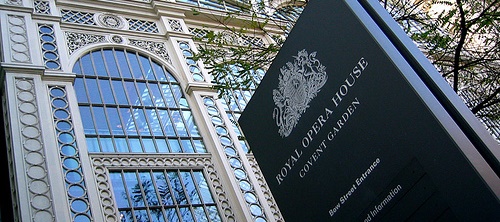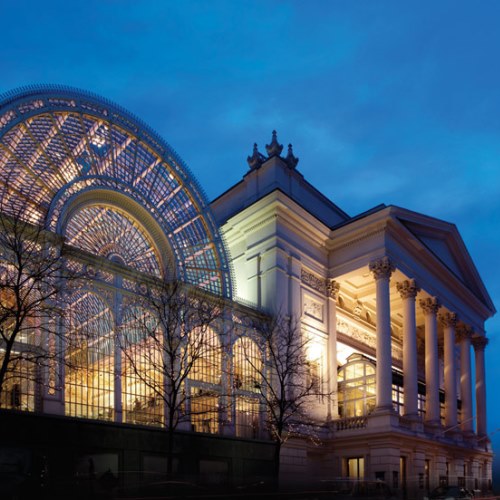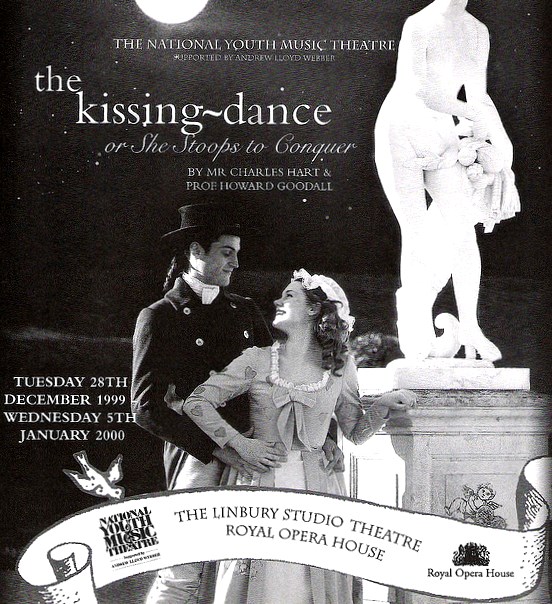
Royal Opera House
Londres - Angleterre
Construction: 1731

Topologie du théâtre
Nombre de salles actives: 3
Salle 1: Main Auditorium (2256) 1731 - Actif
Salle 2: Linbury Studio Theatre (400) 1731 - Actif
Salle 3: Clore Studio (200) 1731 - Actif
Accès
En métro: Covent Garden
En bus: 1, 4, 6, 9, 11, 13, 15, 23, 26, 68, 76, 77a, 91, 168, 171, 176, 188, 501 (southbound only), 505, 521, X68
Adresse: Bow Street, Covent Garden, London WC2E 9DD
Evolution
Bâtiment: 1731. First theatre designed by Edward Shepherd for John Rich / 1791. Theatre modernized by Henry Holland for Thomas Harris / 1808. Building burnt down. Sir Robert Smirke designs new theatre / 1847. Theatre reopens following its remodelling by Benedict Albano / 1856. Building burnt down. Rebuilt by architect Edward M. Barry to reopen 1858 / 1900. Edwin O. Sachs modernizes and rebuilds the backstage area / 1999. Following complete restoration of historic fabric and partial rebuilding, the Royal Opera House reopens on 4 December / Statutorily Listed Historic Building: Grade I. Floral Hall Listed Grade II
Nom:
Propriétaire(s)
Remarquable
The premier opera house in Great Britain. Architecturally distinguished both as an historic building and as a world-class arts venue.

Main Auditorium
2256
1731 - Actif

Linbury Studio Theatre
400
1731 - Actif

Clore Studio
200
1731 - Actif
The Royal Opera House lies less than a mile to the west of Londlnlum, which fell Into serious decline with the cqllapse of the Roman Empire In the late 4th century ad. Superseding the city at the end of the 6th century ad, Saxon Lundenwic flourished In the area of Aldwych, the Strand and Covent Garden. It was with the aid of Royal Opera House monies that the Museum of London carried out an exhaustive and rewarding archaeological excavation on part of Its two-acre site In 1996, prior to the commencement of rebuilding works, which revealed an Important centre of International trade and commerce.
During the medieval period the land reverted to partially enclosed pasture, owned by the great Benedictine Abbey of St Peter, Westminster - hence the name Covent Garden, which derives from ‘convent garden'. In the mid-17th century the flower and vegetable market arrived to occupy the piazza created in the 1630s by Inigo Jones.
Theatrical performances were suppressed during the Commonwealth (1649-60), but at the restoration of the monarchy Charles II granted two letters patent licensing the recipients to operate theatrical companies. The first was granted to the Poet Laureate William D’Avenant and his Duke’s Company (named for D’Avenant's patron, the Duke of York), on 15 January 1662, and the second to Thomas Kllllgrew and his King’s Company, on 25 April 1662. Thus was created a virtual joint monopoly on dramatic performances in London. D’Avenant's patent was obviously of immense value, and by 1714, after being sold on, was in the ownership of the famous harlequin and virtual Inventor of pantomime, John Rich, who opened his Lincoln’s Inn Fields Theatre that same year. Having struggled to make ends meet over the inten/enlng 14 years, by extreme good fortune Rich found financial success with his first staging of John Gay’s The Beggar’s Opera In 1728, and with his new-found wealth decided to build a grand theatre to upstage Drury Lane, on a plot he leased In Covent Garden In 1731.
The site occupied the northeast angle of Jones’s piazza, which was by this time somewhat less than socially desirable and hemmed in by houses and shops. Edward Shepherd, Rich’s architect at Lincoln’s Inn Fields and creator of Shepherd Market in Mayfair, was commissioned to build the new theatre, which he did in the stock Georgian tradition, utilizing a rectangular fanned auditorium with pit benches, three tiers of boxes to the sides, and boxes and two galleries to the rear. John Rich saw his theatre open, but died in 1761, whereupon control passed to the superlative administrator Thomas Harris, who in 1791 engaged Henry Holland (the partner of Capability Brown) to remodel the auditorium incorporating a proscenium stage.
On 20 September 1808 the building burnt down, and a replacement, entered from Bow Street through a solid Grecian portico, was designed by Sir Robert Smirke, architect of the British Museum. To finance the expensive new building, admission prices were raised by 6d and 1s, sparking off 67 days of what became known as the ‘Old Price’ riots. In the 1840s opera was established in the theatre following the arrival of Michael Costa and his company of singers from Her Majesty's Theatre, which they had left after a row. As a result the building had to be brought Into line with European opera houses, and for this task the slightly dubious figure of Mr Benedict Albano was hired to remodel the auditorium once more, providing six tiers of boxes. The duly reconfigured theatre reopened as the Royal Italian Opera House in 1847; but the fates were again unkind, and it burnt down on 5 March 1856.
The architect commissioned to rebuild the theatre yet again was 26-year-old Edward M. Barry, son of Sir Charles Barry, the designer of the Palace of Westminster (1835-60), and he rose to the occasion with a very beautiful neo-Palladian fireproof structure which opened on 15 May 1858. Designed on a horseshoe plan, boxes - pit, grand and first tier - enclosed the pit and pit stalls, above which were amphitheatre stalls and side galleries. It was a layout especially advantageous for those who wanted to see and to be seen. Adjacent to the new building, Barry provided a graceful Itallanate cast-iron Winter Garden annex for his opera house. Although the so- called Floral Hall was badly damaged by fire in 1956, it has been carefully restored to enhance the present-day renovated complex with additional circulation space. A new, uncompromising block to the south of the Floral Hall has been visually disengaged by the Introduction of a fully glazed escalator enclosure, an architectural manoeuvre common in restoration work on historic buildings.
In 1900 Edwin O. Sachs, an authority on safe theatre design, Installed an Asphaleia system of five hydraullcally operated Iron bridges, which formed a permanent stage floor. Above this the stage was counterweighted with a cyclorama and thunder run, in situ in the 1970s. All have since been removed, a serious loss in terms of theatre history, but fully justified In terms of the 21st-century site redevelopment, which has created a wonderful self-contained theatre village that incorporates elements ranging from ballet studios and craft departments to run-of-the-mill administration and finance departments. Two studio theatres, the Linbury (seating 420) and the Clore (seating 200), have been designed into the complex. The architects for this scheme were Jeremy Dixon,
Edward Jones and Charles Broughton, and to find fault with their work would be pernickety in the extreme. Nothing can be said in a short piece that will do adequate justice to their achievement, but Marcus Blnney found the appropriate phrase when he wrote, ‘From the moment you step through the doors you will be enthralled.’
1731. First theatre designed by Edward Shepherd for John Rich / 1791. Theatre modernized by Henry Holland for Thomas Harris / 1808. Building burnt down. Sir Robert Smirke designs new theatre / 1847. Theatre reopens following its remodelling by Benedict Albano / 1856. Building burnt down. Rebuilt by architect Edward M. Barry to reopen 1858 / 1900. Edwin O. Sachs modernizes and rebuilds the backstage area / 1999. Following complete restoration of historic fabric and partial rebuilding, the Royal Opera House reopens on 4 December / Statutorily Listed Historic Building: Grade I. Floral Hall Listed Grade II
The premier opera house in Great Britain. Architecturally distinguished both as an historic building and as a world-class arts venue.

Musical
Original
6) Lost Thing (The) (Original)
Joué durant 4 semaines
Première preview: 07 December 2019
Première: 07 December 2019
Dernière: 04 January 2020
Salle: Linbury Studio Theatre (400 places)
Compositeur: Jules Maxwell •
Parolier: Jules Maxwell •
Libettiste:
Metteur en scène: Ben Wright •
Chorégraphe: Ben Wright •
Avec:
Commentaire: Experience a musical reimagining of Shaun Tan's beautifully illustrated book about a boy who helps a lost thing find its way home. In this enchanting collaboration between Candoco Dance Company and The Royal Opera, a cast of disabled and non-disabled singers, dancers and musicians, come together to tell a story about how we are all connected. Sung in English (plus)
Presse:
Plus d'infos sur cette production:
Plus d'infos sur ce musical
Parolier: Jules Maxwell •
Libettiste:
Metteur en scène: Ben Wright •
Chorégraphe: Ben Wright •
Avec:

Spectacle
Original
5) Laurence Olivier Awards 2016 (Original)
Joué durant
Première preview: 03 April 2016
Première: 03 April 2016
Dernière: 03 April 2016
Salle: Main Auditorium (2256 places)
Compositeur: *** Divers •
Parolier: *** Divers •
Libettiste: *** Divers •
Metteur en scène:
Chorégraphe:
Avec: Présenté par Michael Ball
Commentaire: Eligibility: any new production that opened between 26 February 2015 and 16 February 2016 in a theatre represented in membership of the Society of London Theatre was eligible for consideration, provided it had performed at least 30 performances.
The following 20 productions, including three operas and one dance, received multiple nominations:
8: Gypsy
7: Kinky Boots
6: Farinelli and the King, Guys and Dolls, The Winter's Tale
5: Bend It Like Beckham
4: Hamlet, In the Heights, Mrs Henderson Presents, Nell Gwynn, Oresteia, People, Places and Things
3: The Father, The Force of Destiny, Hangmen
2: Cavalleria rusticana / Pagliacci, Les liaisons dangereuses, The Queen of Spades, Seven Brides for Seven Brothers, Woolf Works
The following six productions, including one dance, received multiple awards:
4: Gypsy
3: In the Heights, Kinky Boots
2: Hangmen, People, Places and Things, Woolf Works (plus)
Presse:
Plus d'infos sur cette production:
Parolier: *** Divers •
Libettiste: *** Divers •
Metteur en scène:
Chorégraphe:
Avec: Présenté par Michael Ball
The following 20 productions, including three operas and one dance, received multiple nominations:
8: Gypsy
7: Kinky Boots
6: Farinelli and the King, Guys and Dolls, The Winter's Tale
5: Bend It Like Beckham
4: Hamlet, In the Heights, Mrs Henderson Presents, Nell Gwynn, Oresteia, People, Places and Things
3: The Father, The Force of Destiny, Hangmen
2: Cavalleria rusticana / Pagliacci, Les liaisons dangereuses, The Queen of Spades, Seven Brides for Seven Brothers, Woolf Works
The following six productions, including one dance, received multiple awards:
4: Gypsy
3: In the Heights, Kinky Boots
2: Hangmen, People, Places and Things, Woolf Works (plus)

Musical
4) Rise and Fall of the City of Mahagonny ()
Joué durant 3 semaines
Première preview: 10 March 2015
Première: 10 March 2015
Dernière: 04 April 2015
Salle: Main Auditorium (2256 places)
Compositeur: Kurt Weill •
Parolier:
Libettiste: Bertolt Brecht •
Metteur en scène: John Fulljames •
Chorégraphe:
Avec: Anne Sofie von Otter (Leocadia Begbick), Peter Hoare (Fatty), Willard W White (Trinity Moses), Christine Rice (Jenny Smith), Kurt Streit (Jimmy McIntyre), Jeffrey Lloyd-Roberts (Jack O'Brien), Darren Jeffrey (Bank Account Billy), Neal Davies (Alaska Wolf Joe), Hubert Francis (Toby Higgins), Anush Hovhannisyan, Lauren Fagan, Meeta Raval, Anna Burford, Harriet Williams, Stephanie Marshall.
Commentaire:
Presse:
Plus d'infos sur cette production:
Plus d'infos sur ce musical
Parolier:
Libettiste: Bertolt Brecht •
Metteur en scène: John Fulljames •
Chorégraphe:
Avec: Anne Sofie von Otter (Leocadia Begbick), Peter Hoare (Fatty), Willard W White (Trinity Moses), Christine Rice (Jenny Smith), Kurt Streit (Jimmy McIntyre), Jeffrey Lloyd-Roberts (Jack O'Brien), Darren Jeffrey (Bank Account Billy), Neal Davies (Alaska Wolf Joe), Hubert Francis (Toby Higgins), Anush Hovhannisyan, Lauren Fagan, Meeta Raval, Anna Burford, Harriet Williams, Stephanie Marshall.

Musical
Revival
3) Into the woods (Revival)
Joué durant 1 semaine
Première preview: 14 June 2007
Première: 18 June 2007
Dernière: 30 June 2007
Salle: Linbury Studio Theatre (400 places)
Compositeur: Stephen Sondheim •
Parolier: Stephen Sondheim •
Libettiste: James Lapine •
Metteur en scène:
Chorégraphe:
Avec:
Commentaire:
Presse:
Plus d'infos sur cette production:
Plus d'infos sur ce musical
Parolier: Stephen Sondheim •
Libettiste: James Lapine •
Metteur en scène:
Chorégraphe:
Avec:

Musical
Revival
2) Sweeney Todd (Revival)
Joué durant 1 mois
Nb de représentations: 9 représentations
Première preview: 15 December 2003
Première: 15 December 2003
Dernière: 14 January 2004
Salle: Main Auditorium (2256 places)
Compositeur: Stephen Sondheim •
Parolier: Stephen Sondheim •
Libettiste: Hugh Wheeler •
Metteur en scène: Neil Armfield •
Chorégraphe:
Avec: Thomas Allen (Sweeney Todd), Felicity Palmer (Mrs Lovett), William Dazely (Anthony), Jonathan Veira (Judge Turpin), Rebecca Evans (Joanna), Doug Jones (Tobias), Bonaventura Bottone (Pirelli), Rosalind Plowright (Beggar Woman), Robert Tear (Beadle)
Commentaire: This production originated at the Lyric Opera House Chicago where its performance was accepted without question. When it came to Covent Garden it was subject to much discussion. Was it an “opera” or a “musical”? Did it really belong in the Opera House? Did it work when performed by proper opera singers rather than musical theatre actors? Did it really need the radio microphones that were used? And, since it was sung in English, why did the production use sur-tities? The critics mused and differed on all these questions, but were almost unanimous in agreeing that the score, with a 50 piece orchestra, conducted by the legendary Paul Gemignani, would probably never be better performed. The physical production was a bit sparse, and the opera chorus occasionally looked uncomfortable when required to “act” - but, all in all, this was regarded as a feather in the cap of the Royal Opera (even if not quite as glorious a feather as the recent Opera North version at Sadler’s Wells.) (plus)
Presse:
Plus d'infos sur cette production:
Plus d'infos sur ce musical
Parolier: Stephen Sondheim •
Libettiste: Hugh Wheeler •
Metteur en scène: Neil Armfield •
Chorégraphe:
Avec: Thomas Allen (Sweeney Todd), Felicity Palmer (Mrs Lovett), William Dazely (Anthony), Jonathan Veira (Judge Turpin), Rebecca Evans (Joanna), Doug Jones (Tobias), Bonaventura Bottone (Pirelli), Rosalind Plowright (Beggar Woman), Robert Tear (Beadle)

Musical
1) Kissing Dance (The) ()
Joué durant 1 semaine
Première preview: 28 December 1999
Première: 28 December 1999
Dernière: 05 January 2000
Salle: Linbury Studio Theatre (400 places)
Compositeur: Howard Goodall •
Parolier: Charles Hart •
Libettiste: Charles Hart •
Metteur en scène: Russell Labey •
Chorégraphe: Wendy Cook •
Avec: Paul Street, Sophie Smith, Spencer Noll, James Hoare, Sheridan Smith, Ian Virgo, Gina Beck, Stacey Kitson, Akiya Henry, Emma Trow, Emma Jacobs, Jess Brooks, Alexander Hassell, Michael Jibsn, Simon Thomas, Neil NcDermott, Kristopher Smith, Gary Tushaw
Commentaire: Over the Christmas & New Year period of 1999/2000 The Kissing-Dance was the first full-length production to grace the stage of the new Linbury Studio Theatre at the Royal Opera House, Covent Garden. This was its professional premiere. (plus)
Presse:
Plus d'infos sur cette production:
Plus d'infos sur ce musical
Parolier: Charles Hart •
Libettiste: Charles Hart •
Metteur en scène: Russell Labey •
Chorégraphe: Wendy Cook •
Avec: Paul Street, Sophie Smith, Spencer Noll, James Hoare, Sheridan Smith, Ian Virgo, Gina Beck, Stacey Kitson, Akiya Henry, Emma Trow, Emma Jacobs, Jess Brooks, Alexander Hassell, Michael Jibsn, Simon Thomas, Neil NcDermott, Kristopher Smith, Gary Tushaw
